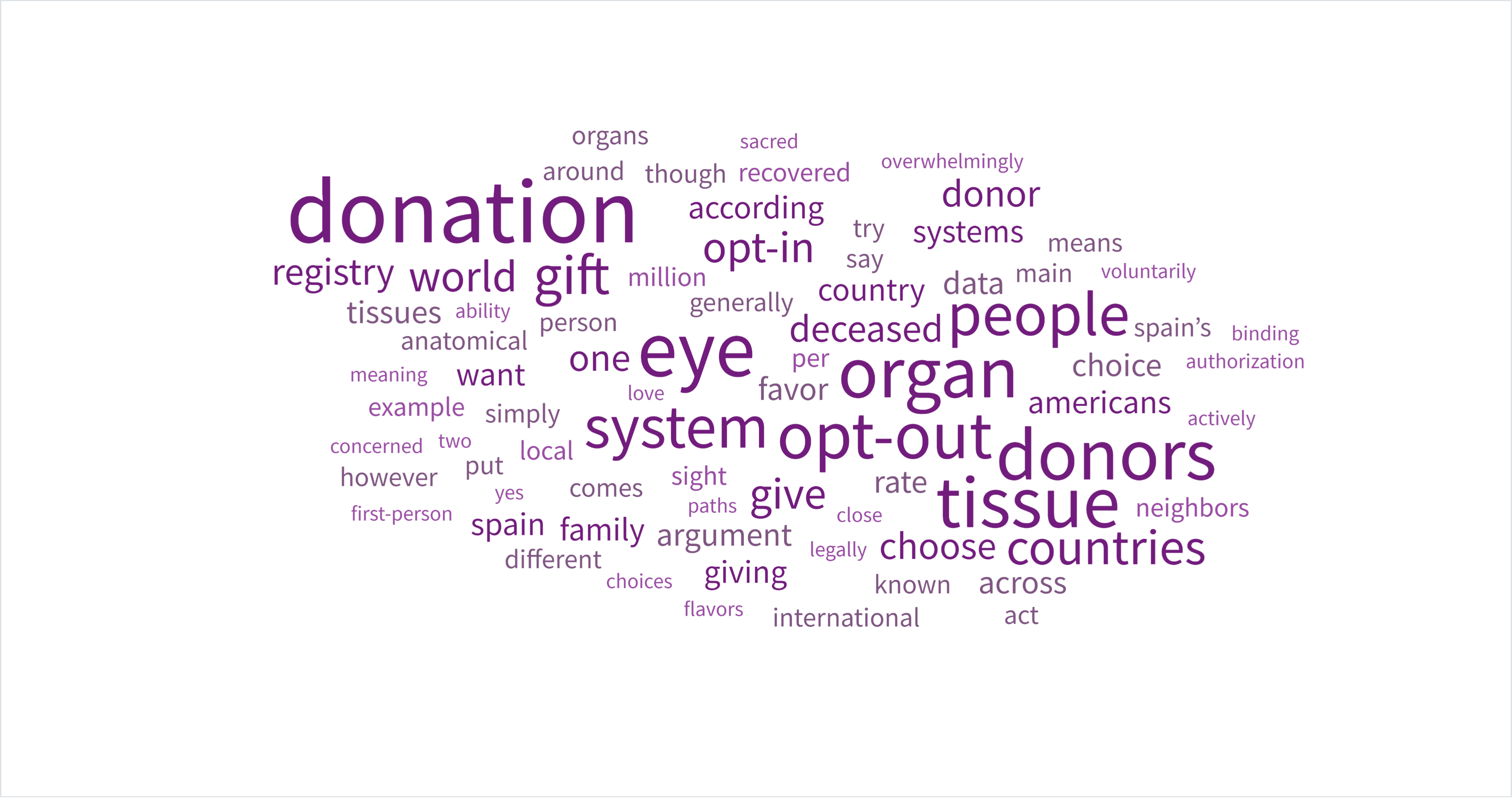Definitions in Donation: Opt-In vs. Opt-Out
The U.S. is unique when it comes to eye, organ and tissue donation because we get to choose and many choose to give
By Kerry Halladay - December 27, 2023
Americans love to make their own choices. The ability to choose our own paths is close to sacred in this country. When it comes to eye, organ and tissue donation, Americans get to choose. And — overwhelmingly — we choose to give.
Countries around the world generally come in two categories where eye, organ and tissue donation is concerned; opt-in and opt-out.
The U.S. is an opt-in country, meaning people who want to be donors must actively and voluntarily say “yes” to being on the donor registry. This is also known as giving first-person authorization, which is legally binding according to the passage of the Uniform Anatomical Gift Act. For most people in the U.S., this looks like checking a box on the form when getting or renewing their driver license or state-issued ID card. For a few, it can look like signing up online.
Other opt-in countries include Australia, Canada, Japan, and Mexico.
By contrast, opt-out countries are those in which a person is presumed to be a donor unless they explicitly say “no” to donation. Spain is famously known for its opt-out status, though other countries are also opt-out, including England, France, and Singapore.
The logistics of how opt-out systems work varies by country. However, opting out generally requires people who do not want to be donors to either leave a written statement of their opposition, tell family about their position, remove themselves from a donation registry, or place themselves on a refusal registry. Some opt-out systems involve multiple elements.
Why Different Systems?
There are many arguments worldwide in favor of one system over the other, and each comes with its own nuance. It’s hard to summarize such a variety of perspectives, but we’ll try anyway.
Very simply put, the main argument in favor of the opt-in system is that it gives people the choice; they must take voluntary action if they want to donate. The U.S. system is based on gift law and is governed by the Universal Anatomical Gift Act referenced above, which positions and regulates eye, organ and tissue donation after death as a gift someone leaves to another person. This gift means there is no financial burden or cost to loved ones or family resulting from the donation.
Similarly, simply put, the main argument in favor of the opt-out system is that organs and tissues are life-saving limited resources, so we should try to maximize their availability. In many countries where citizen sentiment on organ and tissue donation has been gauged, populations are usually very supportive. So, the opt-out system supposedly capitalizes on that support to increase the number of available organs and tissues.
Americans Choose to Give
Spain has long been a leader across the world for organ donation. Its success is often used as an argument for the value of an opt-out system. But the giving spirit of the U.S. and its opt-in system has challenged — and occasionally eclipsed — Spain’s dominance in donation.
According to the International Registry in Organ Donation and Transplantation (IRODT) — the only group that organizes international organ (but not tissue or eye!) donation information — Spain had the highest deceased organ donation rate in 2022 at 46 donors per one million people. By comparison, the U.S. had a rate of 44.5 deceased donors per one million people.
In both 2021 and 2020, however, the U.S. deceased donor rate was higher than Spain’s!
There are limitations to the IRODT’s data, though. For example, it only tracks data on organ donors rather than tissue donors. This means that eye tissue donors are not captured in this data.
The U.S. has a very rigorous system of eye tissue donation. According to the Eye Bank Association of America, eye tissues were recovered from 61,747 deceased donors in the U.S. in 2022.
Those donors decided to give the gift of sight to a stranger. The lives of corneal transplant recipients are forever changed for the better due to that donor’s selfless choice. The people who receive those gifts can be local neighbors living in the same state, fellow U.S. residents, or even over half a world away. In other words, your very neighbors are choosing to give sight to people from your local communities to those across the world!
For example, eye tissue recovered by RMLEB from donors in Colorado and Wyoming went to over 23 different countries around the world in 2022. And we are just one of dozens of eye banks across the U.S.
During this time of giving, and as we turn to the renewal of the New Year, consider what your choice to be an eye, organ, and tissue donor could mean for others. You could give a gift that saves a life or brings light to another’s eyes. And, please, discuss your decision with your family.
.png)
RMLEB sent eye tissues to at least 23 different countries in 2022: Argentina, Armenia, Bangladesh, Chile, Dominican Republic, Egypt, Germany, Greece, Iraq, Ireland, Japan, Malaysia, Morocco, Norway, Pakistan, Rwanda, Saudi Arabia, Switzerland, Taiwan, Turkey, UK, unknown/other, and US
